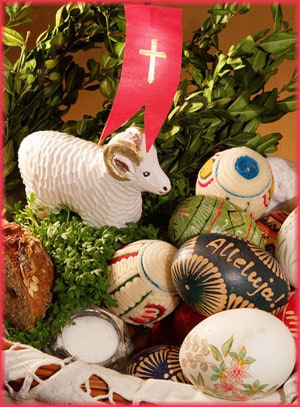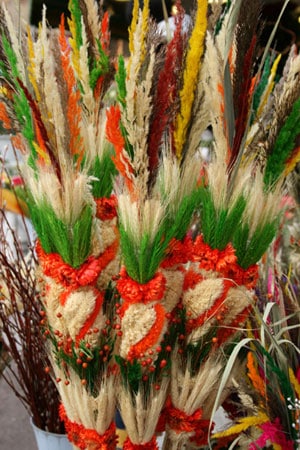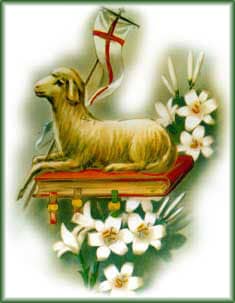
POSWIECANIE
(sacrificing):

DROGA KRZYŻOWA, GORZKIE ŻALE
(Stations of the Cross, Bitter Lamentations):
These beautiful, old Polish Lenten devotions may still be encountered here and there across Polonia. They are worth attending for at least a temporary escape from daily routine. These religious services can give us a new perspective on things, and their inspiring message, couched in rich Baroque imagery, stands in marked contrast to all the silly, shallow, empty entertainment that
POLSKIE PALMY WIELKANOCNE
(Polish Easter 'palms’):

POLSKI KIERMASZ WIELKANOCNY
(Polish Easter fair or bazaar):
Any time from Palm Sunday through Holy Saturday is a good time to hold such an event. Good Friday is the exception, when such commercial activities might detract from the prayerful solemnity of the occasion. Depending on the capacity of the organizers and local demand this could be mainly a bake sale, a craft fair or a bazaar of assorted Easter artifacts, or it could be all three rolled into one. Items could include: Polish Easter 'palms’, pisanki (Easter eggs — real and wooden), pisanki-making kits (perhaps even a pisanki-making demonstration), Easter lambs, wicker Easter baskets, Polish cook books, recorded Easter hymns and possibly also such typically Polish Easter plants (pussy willows, cress, young oats, daffodils, hyacinths, tulips). Foods might include different kinds of Polish sausage and ham, Easter soup (zur or bialy barszcz), horseradish, æwikla, Polish-style rye bread and holiday cakes: babka, placek drozdzowy, mazurek, sernik, pascha, kolacz and chalka. If properly publicized, this could be a good fund-raiser for your parish, society or club.
WIELKANOCNE ZAKUPY WYSYŁKOWE
(mail-order Easter shopping):
Polish Easter treats and artifacts of every type may be ordered from one of America’s top suppliers in this field. These include Easter eggs of every type as well as egg-coloring kits, books on Polish customs and traditions, videos, recordings, gift items, folk crafts, sweets, cookies and much more. If you are holding an Easter bazaar and plan to order in quantity, you can expect a good discount, enabling your fund-raiser to show a profit.
TOPIENIE LUB PALENIE JUDASZA
(drowning or burning Judas):
This custom is usually practiced on Holy Wednesday and has all the makings of something that could catch on with Polish-American school children. Especially on the last day of school before Easter vacation. A straw effigy (dummy) of a bearded Judas is dressed in a long black cloak or any rags that are available. The dummy holds a cloth bag containing shards of broken glass (symbolizing the 30 pieces of silver for which he betrayed Jesus) which jingle when the effigy falls. It is taken to the top of a church steeple and hurled to the ground where it is pounced upon by youngsters with sticks. Judas is dragged through the streets and dumped in the nearest body of water amid the cheers of all present. If there is no water nearby, the effigy may be burned.
WIELKI CZWARTEK
(Holy Thursday):
The liturgy of Holy Thursday commemorates the Last Supper and the institution of the priesthood. In cathedrals, bishops wash the feet or 12 elderly men the way Christ washed the feet of his Apostles. All church bells fall silent on this day, not to be heard again until Easter Sunday. Instead of tinkling altar bells, wooden clappers are used to announce the Elevation. The Blessed Sacrament is transferred to the ciemnica (altar of repose), where it is venerated by the faithful during a night-long vigil. In the olden days, boys would run house to house, call the occupants to church with wooden clappers and expect a small token for their effort.
WIELKI PIĄTEK — GROBY PAŃSKIE
(Good Friday):
To Christians world-wide, this is traditionally the saddest and most solemn day of the year. In the olden days, many Poles abstained from all food and drink on Good Friday. The faithful flock to church for services commemorating the Passion and Death of Christ. The devotions include Veneration of the Cross. Altar boys hold up a large crucifix and worshipers line up and take turns piously kissing it. A focus of prayer and meditation is a tableau of Christ’s Tomb, usually set up at one of the church’s side altars. The tableau shows a figure of Christ lying in His grave, but the actual artistic execution varies from parish to parish. Sometimes Christ is seen lying in a tomb fashioned from crumpled gray or brown paper, meant to resemble a rocky grotto. Often the scene is set against a painted backdrop depicting the three crosses atop Calvary, silhouetted against the buildings of Old Jerusalem. Usually the tomb is surrounded by flowers, ferns, assorted greenery and potted palms as well as flickering candles and votive lamps. Rotating honor guards (veterans, parish activists, the previous year’s First Holy Communicants, boy and girl scouts, etc.) enhance the significance of this beautiful old tradition. If your parish has drifted away from this custom, perhaps its pastor could be persuaded to reintroduce it. In Poland it is common to visit the Lord’s Tomb tableaux in different churches. Perhaps an organized bus tour of your area’s Polish parishes might be worth considering.
WIELKANOCNE POZDROWIENIA
(Easter greeting):
The traditional Polish greeting at Easter time is 'Wesolego Alleluja’. Literally it means 'happy alleluia’, but is normally translated as 'Happy Easter’. When sending someone an English-language Easter card, add the words 'Wesolego Alleluja’ for a touch of cultural flavor. The greeting should be prominently displayed during the Easter season on banners, posters, lettering and other items decorating your parish, school, social hall and clubrooms as well as Polish-American stores and other places of business. Let our non-Polonian friends and neighbors as well as the general American public become exposed to it, just as we Polish Americans have become familiar with such terms non-English terms as Mardi Gras, piñata, ciao, Oktoberfest, bon voyage, pizzeria, Gesundheit, smörgasbord, déjà vu, tacos, etc.
SWIĘCONKA
(Easter food table):
This special Easter can be set up in someone’s home when there is no Polish parish that practices the Holy Saturday food blessing nearby. 
A priest can be then invited to perform the blessing for many families and individuals gathered there. At community Easter parties (swieconkas), an elaborate swieconka table could serve as the event’s artistic centerpiece. The central figure is a fairly large Easter lamb, made of plaster, cake or butter. It is surrounded by traditional Easter foods: ham (preferably whole), coils of kielbasa, Easter eggs, bread, babkas, perhaps also sparkling (preferably crystal) decanters of wine and spirits. Gladness of the coming Resurrection, the joy of spring and an abundance of festive foods, all artistically arranged — such is the impression the table should convey. The table should therefore feature plenty of greenery illustrating the central Easter theme of rebirth after death. Sprigs of box (small-leafed evergreen) adorn food platters and cakes. A large vase of pussy willows, potted palms and ferns, vases of daffodils and tulips in the background help set the proper seasonal mood. Garlands of boxwood or cranberry leaves, draped round the sides of the table, will strike a nice contrast against the pure-white table-cloth. Additional suggestions are provided in the following entry.
KRZYŻ WIELKANOCNY Z JAJ
(Easter egg cross):
This arrangement is mainly for visual effect and is typical of the treatment lavished on the swieconka table in the better-to-do Polish homes of yesteryear. A rectangular serving dish or tray is best, but a round one can be used as well. Count the number of eggs needed to make a cross. You will need only half the number is you serve egg halves. Place the required number of cold, peeled, hard-cooked eggs in a bowl or jar and drench them with beet juice (from canned or pickled beets). Weight down with a plate to keep them submerged and refrigerate over night. Remove, drain on dry on paper towel. If using egg halves, place them on platter cut side down. If using whole eggs, cut a thin slice (1/8″) off the bottom of each egg to make them more stable. (Chop the egg trimmings and add to any of the salads presented here.) Form a cross with the red eggs and surround them with either plain hard-cooked eggs or drenched with a white or light-colored sauce.
BARANEK Z JAJ
(Easter egg lamb):
The same principle applies here too. Here you will need only a few beet-colored eggs for the red cross of the lamb’s banner. A rather large platter or tray is needed. Fill the serving platter with eggs (whole or halved). Use plain eggs for the lamb and drench the eggs outside its outline with green sauce. The banner should be white with beet-red eggs forming the cross. Decorate with greenery as above.
SWIĘCENIE POKARMÓW
(Holy Saturday food blessing):
This is one of the most popular traditions with Poles everywhere, and also appeals to many non-Poles who have been exposed to it. Nowadays the blessing takes place on Holy Saturday at church. The faithful bring baskets containing a cross-section of Easter foods which are blessed by a priest. Typically a basket, lined with a linen or lace napkin, contains Easter eggs, sausage, ham, bread, horseradish, salt & pepper (sometimes also vinegar), babka or other Easter cakes. An absolute 'must’ is the Easter lamb, usually made of sugar or butter, but it can also be a non-edible figure made of plaster, wood, cloth or plastic. A sprig of box may be attached to the basket handle for a festive accent. After the blessing it is traditional to pay a visit to and say a prayer at the tableau of Christ’s Tomb. If interest warrants, organizing a bus trip to the nearest parish that practices the blessing might be considered.
REZUREKCJA
(sunrise Easter Mass):
This Mass is held at the break of dawn, usually 6 AM, but individual parishes may begin earlier or later. This is a most festive and uplifting occasion: church bells break their three-day silence and a Eucharistic procession that encircles the outside of the church three times precedes the Mass proper. They process while singing Easter hymns amid the heady scent of incense, as little girls in First Holy Communion dresses strew the way before the Blessed Sacrament with flower petals. The church is blaze with lights and candles, a figure of Christ holding the banner of Resurrection stands on the altar as the tall paschal candle flickers to one side. The tomb tableau no longer contains a figure of Christ. Instead, His shroud may be seen neatly folded. A figure of an angel telling visitors that 'He is risen’ may be found near the tomb instead. Sometimes a large wooden cross draped with a white cloth is displayed. The deeply spiritual atmosphere is heightened by many haunting Easter hymns (see below).
PARAFIALNE SWIĘCONE
(parish Easter breakfast):
The traditional swiecone (Easter breakfast or brunch) normally takes place at home, after family members have returned from Easter Mass. However, in an American setting, where some have drifted away from the custom or live alone, organizing the meal as a community event may not be a bad idea. It could be held in the parish hall or other nearby facility after Rezurekcja or some other Easter Sunday Mass. Grace, the blessing of the food and the sharing of blessed Easter egg wedges precedes the feast. Since people unfamiliar with the customs may be in attendance, these should be explained by the officiating clergyman or master of ceremonies or in a printed program. The printed program could double as a song-sheet by including the words to Polish Easter hymns. The hall should be appropriately decorated with typical Easter flowers and greenery. No Easter rabbits, please! A swieconka table (see above) will help set the proper mood. Colorful pisanki, for instance 3 in a small bowl with a sprig of boxwood and a pussy-willow twig will add a festive touch to the tables, as will butter lambs. The program might include community singing of Easter hymns and/or the re-enactment of traditional Easter customs (see Easter Kaleidoscope below).

(Polish Easter hymns):
It is true that koledy (Christmas carols) have become more extensively 'folklorized’, hence they are better known than Poland’s traditional Easter hymns which have retained their strictly religious nature. But that is all the more reason to popularize the latter. These ancient songs tell the story of Christ’s Resurrection in beautiful, often slightly archaic language which only heightens the aura of mystery and spirituality they convey. Among the best known are 'Wesoly nam dzis dzien nastal’, 'Otrzyjcie już łzy, płaczący’, 'Nie zna smierci Pan żywota’, 'Zwycięzca smierci’, 'Chrystus zmartwychwstan jest’ and many others. Their words should be printed on song-sheets which can be distributed at various functions during the Easter season.
SMIGUS-DYNGUS, LANY PONIEDZIAŁEK
(Wet Easter Monday, Dyngus Day):
In Poland, Easter Monday is a legal holiday, so it starts with Holy Mass and more high-powered feasting. To the younger set – youngsters, teens and young adults – it also means the drenching custom known as smigus-dyngus. This custom also appeals to Polish-American youngsters and is therefore easy to promote. Although Easter Monday is not a free day in America, in some parts of the country Dyngus Day is celebrated in halls and clubs with good food, drink, music and general merriment. Interestingly enough, two cities best known for their Dyngus Day celebrations are Buffalo, New York, and South Bend, Indiana. In many respects, the event is similar to the swieconka parties usually held across Polonia during the first weekend after Easter (see below).
CHODZENIE PO DYNGUSIE
(Easter trick-or-treating):
The Polish tradition of chodzenie stretches from Christmas on through the New Year-Mardi Gras season, takes a 40-day Lenten break, and re-emerges on Easter Monday. Dyngus revelers streak their faces with soot or dress as Gypsies or simply come in street clothes dragging along a special rooster cart — a gaily painted toy wagon containing a live, stuffed or wooden rooster which symbolizes vitality and robust health. They recite mock sermons and sing humorous ditties, begging for money or treats and threatening to drench the householders if they refuse. Here is one such dyngus-begging song in the Polish original and my translation:
Przyszliśmy tu po dyngusie
Zaśpiewamy o Jezusie
O Panience, Swiętym Piotrze,
O Judaszu i o łotrze.
A gosposiu, skrzętna szczera,
Daj nam wódki, chleba, sera.
Easter begging we have come,
About our Jesus we’ll sing a song.
About the Virgin and Saint Pete,
About old Judas and the thief.
Generous housewife, if you please,
Give us vodka, bread and cheese.
Other forms of house-to-house Easter visits included dziady smigusne (Easter beggars), who wore outfits of woven straw, and young girls making their rounds carrying a gaik or maik (little grove), an evergreen branch festooned with ribbons and paper flowers. Local conditions should be taken into account when deciding the best way to promote such customs in Polonia: in its house-to-house form or perhaps as a stage presentation at swieconka parties? Polish dance groups have the costumes and the general feel for folk climates needed to stage such a performance. Perhaps as visit by dyngus trick-or-treaters would be enjoyed by the residents of a local nursing home.
SWIĘCONKA
(swięconka party, Easter social):
The idea of a community Easter social is an indigenously Polish-American custom unknown in Poland, where the traditional Easter brunch has always been strictly a family affair. But the swieconka community Easter party has been held in Polonian parishes and clubs as long as anyone can remember. It therefore deserves to be perpetuated and perhaps enriched and expanded to include more genuinely Easter-related motifs, menus and activities. Unfortunately, the events sponsored by some Polish-American groups are often little more t han reruns of what might be called the 'golabki–cash-bar–polka-dance’ format. Regardless of whether they are called dozynki (harvest festival), oplatek-dinner or swieconka, the routine remains monotonously the same. Is it any wonder that such uninspiring, run-of-the-mill functions attract so few younger people?! To do things up right, the hall should be appropriately decorated (see 'Parish Easter Breakfast’ above) to set the right mood.
Guests should be greeted by a large 'Wesolego Alleluja’ banner, preferably incorporating Easter lamb, pisanki and pussy-willow motifs. The menu should feature typical Polish Easter foods: Easter soup, hard-cooked eggs prepared in different ways, ham and other cold meats, jellied pig’s feet, kielbasa cold and hot, bigos, cwikla, sauces, salads, and seasonal cakes: babka, mazurek, sernik, pascha, placek z kruszonka and kolacz. Activities might include a Polish Easter hymn concert and/or community singing (song sheets provided). A Polish Easter Kaleidoscope, or even a review additionally incorporating Mardi-Gras and Lenten traditions, could be presented on stage. Instead of an Anglo-Germanic Easter-egg hunt, youngsters can engage in such Easter games as kulanie jajec (egg rolling): eggs are rolled down an inclined board to see whose rolls the farthest. Another is known as walatka (egg tapping): two competitors tap their eggs together and the one whose egg remains uncracked is the winner.
TO YOU AND YOURS: Wesołego Alleluja i smacznego swięconego jajka!

